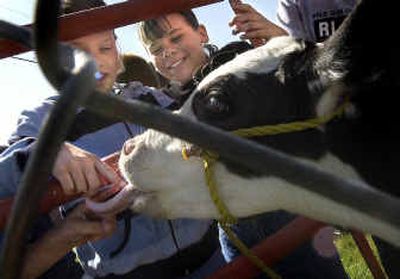Farm animals visit elementary

A slice of country life turned up at Spokane’s Pratt Elementary on Thursday morning.
No, the horse, mule and bottle-fed calves didn’t just happen to wander onto the playground of this urban school. Instead, they arrived by trailer – driven by farmers who wanted to share a piece of their rural existence with city kids in Spokane.
Their presence at Pratt Elementary was more than just a lesson on Eastern Washington agriculture; it also served as a cultural exchange, a chance for people from different lifestyles to learn more about one another.
“There’s a growing disconnect between the folks who live in urban cities and the ones who live in rural areas,” said Bruce A. Vincent, a logger from Libby, Mont., and founder of Provider Pals, which facilitates urban-rural exchange programs throughout the country. “People used to know where their food came from. We’ve grown apart from each other, and we need to bridge that gap.”
The farm visit to Pratt was the first of its kind in Washington.
It all began when Pete Swannack, a wheat farmer from the tiny, Eastern Washington town of Lamont, presented the idea to Sherrie Skladany, a fourth-grade teacher at Pratt. Inspired by Vincent’s program, Swannack wanted to teach kids about farm life and give them a better understanding of the source of their food. It was also a good way to explain the significance of agriculture to Eastern Washington’s economy and its impact on Washington state history, said Skladany.
Except for visits to the county fair, most of the kids in her class had never been to a farm or petted any of the animals, she said. And since it wasn’t possible to bring her students all the way to Lamont – a town of 75 people about 60 miles southwest of Spokane, the next best thing was to bring the farm to school.
It was a treat for the 19 fourth-graders, who took turns bottle-feeding the calves and touching the horse and mule. They also received lessons on lassoing from Bill Oakes, an Oroville, Wash., rancher who wore his cowboy boots and hat.
“Cows have scaly tongues,” said Madeline Crawford, 10, an aspiring veterinarian. “I’m glad we get to experience this in school.”
Before Thursday’s visit, students had been in touch with Swannack and his wife, Sandi, through an exchange of letters. Kids had all kinds of questions about their life on the farm, said Pete Swannack, who donned his farm uniform of tan Carhartt overalls for school.
Born and raised in Lamont, Pete Swannack grows wheat on the same plot of land that his father and grandfather farmed for many decades. But his farm is now much more expansive than the original acreage he inherited from his family. Using tractors, combines and other fancy equipment, the Swannacks plant and harvest winter and spring wheat on about 1,800 acres.
“I definitely knew it was something I wanted to do for the rest of my life,” said the 38-year-old farmer, who gets up each day about 5 a.m. “I enjoy the freedom and the lifestyle.”
Before going out to the playground to pet the animals, students welcomed the Swannacks and other area farmers and ranchers with a big yellow sign decorated with crayon drawings of a farm, a truck and a long road that led to a school building. “Welcome Provider Pals,” it said.
The Swannacks brought photos of their farm, fields and animals, along with actual clumps of both winter and spring wheat that Pete Swannack dug up earlier that morning. One bushel of their wheat, he told the kids, is worth $3.20. Depending on the rainfall, one acre yields about 80 bushels.
For more than an hour, students peppered them with questions.
“Is the mule’s ears as big as an elephant’s ears?” asked one girl.
“Nope,” Pete Swannack replied. “But it’s twice as big as the horse’s.”
“How much does your tractor weigh?”
He’s got three different kinds, he told them. The smallest weighs about 6,000 to 8,000 pounds, but the biggest one would probably kick in at nearly 24 tons.
“What’s your favorite animal?” they asked Sandi Swannack, who grew up in the farming town of Davenport.
“The beef, because they taste good,” she said. “But I also like mules because I enjoy working with them.”
The animals were certainly a hit with the kids, as well, but they also came away with other lessons.
“We use wheat to get money for our state,” said 10-year-old Austin Swem. “We sell wheat to China, and it’s good for our economy.”
“You have to be kind to animals,” said Lydia Boncek, 9. “They’re sweet creatures.”
A graduate of a two-year agricultural leadership program through the Washington Agriculture and Forestry Education Foundation, Pete Swannack hopes to spend more time in urban classrooms when it’s not planting or harvesting season.
He wants to share his love of the land, he said. But most of all, Swannack wants to show kids that he’s no different from any of them.
“People out in the country are the same as people in the city,” he said. “We can all be friends.”